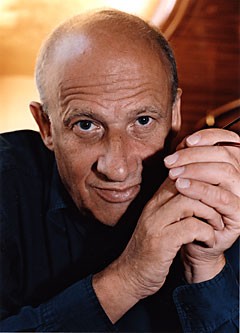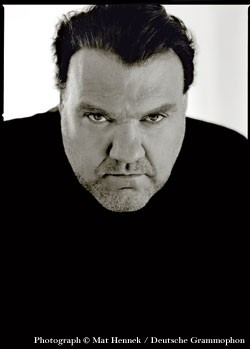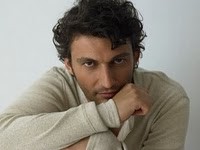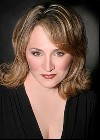Tosca Triumphs at the Metropolitan Opera
Racette, Terfel and Kaufmann Score
By: Susan Hall - Apr 26, 2010
Tosca
by Giacomo Puccini
Conducted by Fabio Luisi
Production Luc Bondy
Set Designer Richard Peduzzi
Costume Desginer Milena Canonero
Lighting Designer Max Keller
Tosca Patricia Racette
Scarpia Bryn Terfel
Cavaradossi Jonas Kaufmann
Metropolitan Opera, New York
Continuing until May 13, 2010
212-362-6000
Luc Bondy’s Tosca returned to the Metropolitan Opera this spring with new artists singing the principal roles and a new conductor. In the fall, audiences loudly booed this production, unless they stayed away altogether from one of their favorite operas.
Blame was heaped on Bondy, the director, although the problems on stage were not of his making. Focus was on the sets, which were simpler than Zefferelli’s, among the most beloved sets in the Met repertoire. Let's face it. Sets at some time can’t be stapled, stitched and hammered together any longer.
Bondy remarked aptly “Tosca is a double opera. It is a wonder and a horror at the same time. Yet if you cover any opera with too much decor, you can’t see it clearly. It’s like sauce. Here is the church-sauce, here is the society-sauce. It becomes too much.”
In focusing on the sets, commentators could avoid the real problem. Karita Mattila, a draw at the Met, was simply wrong for this role. Three years before she sang it at the Met, she had been trashed as Tosca in performances in her homeland, Finland. George Gagnidze was not up to the Bondy concept of Scarpia. Between the two of them, Tosca was brought down. They escaped criticism because it was leveled at Bondy and Peter Gelb, the Met’s general manager.
In the beginning, Puccini saw a production in French of La Tosca with Sarah Bernhardt. He understood not one word, but was moved by the drama. Ah, material for opera. That, backed by the knowledge that Verdi considered La Tosca, but rejected it because he felt too old to take it on, peaked Puccini's interest.
Puccini didn’t begin to work on the opera until he heard that composer Alberto Franchetti and librettist Luigi Illica were composing a Tosca opera. He immediately set about derailing their efforts and taking up the project himself.
What he wrote is a masterful musical drama. With the exception of two revealing arias, “Vissi d”arte,” an afterthought for Tosca, and "E lucevan le stele" for Cavaradossi in Act III, the principals are actors pressing the plot forward and not developed.
Instead Tosca, Scarpia and Cavaradossi are caricatures of love/jealousy, cruelty/lust and youth/enthusiasm. Faced with characters who do not naturally engage the audience, although the story does, Bondy worked to bring these singers to life. Since Mattila cannot sing inside/out, she fell flat, shapeless. While the Scarpia development seemed ugly and diminishing in the fall, Bondy’s wisdom was revealed in the interpretation of Bryn Terfel in the spring. Cavaradossi is sweet enough for any Puccini tenor on the roster to render. Marcelo Alvarez was fine in the fall, but could not sustain the opera alone.
Welcome spring. Tosca arrives fleshed out fully with Patricia Racette, fresh from a triumphant Tosca in Houston. Anyone who has seen Racette perform, knows that she will bring to the creation of Tosca the detailed, note by note, step by step performance that the most glorious of divas deploy. She moves comfortably with the music and suggests the diva's emotional state. Her lovely voice caps the inside/out performance.
Last winter at the Morgan Library, Racette spoke about singing. At the time she was performing all three roles in Il Triittico. She is only one of three sopranos who have tried this hat trick. Racette's performances was praised by critics and when people did not realize she’d sung al three roles, she remarked, ‘Mission accomplished.’
Racette discussed her integration into a role and bringing together the emotional arc and the line of the music. She likes to sing Puccnini and Janacek because they create lines to which it’s easier to attach than Verdi and Mozart who are more vertical.
Now we have a perfect Tosca. The role is performed with a complexity of character which Puccini does not provide, except in the music. Bondy has a chance to realize his concept at last.
Scarpia is the center of the drama. Acolytes and choristers, celebrating a victory over Napoleon, go silent when he arrives. The orchestra cuts to Scarpia’s theme. Harmonic quick cutting is one of the ways Puccini unnerves the audience, torturing us to heighten interest.
Bryn Terfel takes charge of the role. Bondy’s notion to show the tender side of Scarpia, as well as his cruelty and physical lust, are all combined. Nothing Terfel does can diminish him. The tarts at the beginning of Act II, the visceral lust on display in thrusts and parries in his second act duel with Tosca, provide two characters of equal heft sparring to death. With two singers who can convincingly inhabit his concept, Bondy succeeds. It was the weakness of the actors that drove opera aficionados around the bend in the fall. Perfect casting makes this opera moving.
The new Cavaradossi is the most talked about tenor today. The audience went wild for Jonas Kaufmann. Kaufmann’s voice has a baritone center, but he has no problems with the upper tessitura. The tone is odd, because the middle voice is placed in the back of the throat, but it is open. At its best it is beautifully dark.
In Act III, Kaufman displayed an extraordinary, almost inaudible pianissimo. Here, and throughout the score, conductor Fabio Luisi, in for the ailing Levine, showed deference to the singer without compromising the orchestra, no mean feat.
This Tosca is convincing now in a way it was not in the fall. So convincing in fact that you know if Tosca and Cavaradossi were left to live, their relationship would last two, maybe three days.
Bondy is a new Met director who understands the form. He understands it very well, but was not well served by his first cast. The April audience was filled with Europeans stranded by volcanic ash. They loved this show. Subscribers who had been forewarned, had no idea what the warnings were about. They too applauded enthusiastically throughout the performance.
A truly brilliant Tosca at the Met was there all the time, just buried. What a difference a cast makes.




